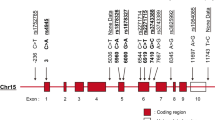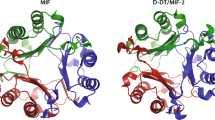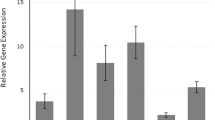Abstract
We have demonstrated that serum macrophage migration inhibitory factor (MIF) was significantly elevated in patients with extensive alopecia areata (AA). Recently, functional polymorphisms have been identified in the MIF promoter region. To address the functional and prognostic relevance of the −173G/C and −794[CATT]5–8 repeat polymorphisms in MIF genes in patients with extensive AA, 113 patients with extensive AA and 194 healthy controls were genotyped. We found that MIF−173*C was a risk factor for early onset (<20 years) of extensive AA (odds ratio for GC heterozygotes with −173G/C was 4.88 (95% CI, 2.04–11.8), P=0.00038; odds ratio for CC homozygotes with −173G/C was 10.42 (95% CI, 2.56–43.5), P=0.0011). We found no statistically significant differences in the genotype frequencies of the −794[CATT]5–8 repeat polymorphism and extensive AA. These results suggest that polymorphisms within the MIF−173*C allele confer an increased risk of susceptibility to the extensive forms of AA, especially with an early onset of disease. MIF is therefore suggested to be closely implicated in the pathogenesis of the more extensive forms of AA.
This is a preview of subscription content, access via your institution
Access options
Subscribe to this journal
Receive 6 digital issues and online access to articles
$119.00 per year
only $19.83 per issue
Buy this article
- Purchase on Springer Link
- Instant access to full article PDF
Prices may be subject to local taxes which are calculated during checkout

Similar content being viewed by others
References
Galbraith GM, Pandey JP . Tumor necrosis factor alpha (TNF-alpha) gene polymorphism in alopecia areata. Hum Genet 1995; 96: 433–436.
Tazi-Ahnini R, Cox A, McDonagh AJ et al. Genetic analysis of the interleukin-1 receptor antagonist and its homologue IL-1L1 in alopecia areata: strong severity association and possible gene interaction. Eur J Immunogenet 2002; 29: 25–30.
Bloom BR, Bennett B . Mechanism of reaction in vivo associated with delayed-type hypersensitivity. Science 1966; 153: 80–82.
Calandra T, Bernhagen J, Mitchell RA, Bucala R . The macrophage is an important and previously unrecognized source of macrophage migration inhibitory factor. J Exp Med 1994; 179: 1895–1902.
Shimizu T . Role of macrophage migration inhibitory factor (MIF) in the skin. J Dermatol Sci 2005; 37: 65–73.
Donn R, Alourfi Z, De Benedetti F, et al, British Paediatric Rheumatology Study Group. Mutation screening of the macrophage migration inhibitory factor gene: positive association of a functional polymorphism of macrophage migration inhibitory factor with juvenile idiopathic arthritis. Arthritis Rheum 2002; 46: 2402–2409.
Baugh JA, Chitnis S, Donnelly SC et al. A functional promoter polymorphism in the macrophage migration inhibitory factor (MIF) gene associated with disease severity in rheumatoid arthritis. Genes Immun 2002; 3: 170–176.
Shimizu T, Nishihira J, Mizue Y, Abe R, Watanabe H, Shimizu H . Increased macrophage migration inhibitory factor (MIF) in sera of patients with extensive alopecia areata. J Invest Dermatol 2002; 118: 555–557.
Olsen EA, Hordinsky MK, Price VH et al. Alopecia areata investigational assessment guidelines—Part II. J Am Acad Dermatol 2004; 51: 440–447.
David JR . Delayed hypersensitivity in vitro: its mediation by cell-free substances formed by lymphoid cell–antigen interaction. Proc Natl Acad Sci USA 1966; 56: 72–77.
Weiser WY, Temple PA, Witek-Giannotti JS, Remold HG, Clark SC, David JR . Molecular cloning of a cDNA encoding a human macrophage migration inhibitory factor. Proc Natl Acad Sci USA 1989; 86: 7522–7526.
Bernhagen J, Calandra T, Mitchell RA et al. MIF is a pituitary-derived cytokine that potentiates lethal endotoxaemia. Nature 1993; 365: 756–759.
Bucala R . MIF re-evaluated: pituitary hormone and glucocorticoid-induced regulator of cytokine production. FASEB J 1996; 7: 19–24.
McDonagh AJ, Tazi-Ahnini R . Epidemiology and genetics of alopecia areata. Review. Clin Exp Dermatol 2002; 27: 405–409.
Tobin SJ . Morphological analysis of hair follicles in alopecia areata. Microsc Res Tech 1997; 38: 443–451.
Harmon CS, Nevins TD . IL-1α inhibits human hair follicle growth and hair fiber production in whole-organ cultures. Lymphokines Cytokines Res 1993; 12: 197–203.
Philpott MP, Sanders DA, Bowen J, Kealey T . Effects of interleukins, colony-stimulating factor and tumour necrosis factor on human hair follicle growth in vitro: a possible role for interleukin-1 and tumour necrosis factor-alpha in alopecia areata. Br J Dermatol 1996; 135: 942–948.
Galbraith GM, Palesch Y, Gore EA, Pandey JP . Contribution of interleukin 1beta and KM loci to alopecia areata. Hum Hered 1999; 49: 85–89.
Tarlow JK, Clay FE, Cork MJ et al. Severity of alopecia areata is associated with a polymorphism in the interleukin-1 receptor antagonist gene. J Invest Dermatol 1994; 103: 387–390.
Shimizu T, Abe R, Ohkawara A, Nishihira J . Increased production of macrophage migration inhibitory factor by PBMCs of atopic dermatitis. J Allergy Clin Immunol 1999; 104: 659–664.
Foote A, Kipen Y, Santos L, Leech M, Morand EF . Macrophage migration inhibitory factor in systemic lupus erythematosus. J Rheumatol 2004; 31: 268–273.
Kleemann R, Hausser A, Geiger G et al. Intracellular action of the cytokine MIF to modulate AP-1 activity and the cell cycle through Jab1. Nature 2000; 408: 211–216.
Donnelly SC, Haslett C, Reid PT et al. Regulatory role for macrophage migration inhibitory factor in acute respiratory distress syndrome. Nat Med 1997; 3: 320–323.
Barton A, Lamb R, Symmons D et al. Macrophage migration inhibitory factor (MIF) gene polymorphism is associated with susceptibility to but not severity of inflammatory polyarthritis. Genes Immun 2003; 4: 487–491.
Donn RP, Shelley E, Oliver WE, Thomson W . A novel 5′-flanking region polymorphism of macrophage migration inhibitory factor is associated with systemic-onset juvenile idiopathic arthritis. Arthritis Rheum 2001; 44: 1782–1785.
Donn R, Alourfi Z, Zeggini E, et al. British Paediatric Rheumatology Study Group. A functional promoter haplotype of macrophage migration inhibitory factor is linked and associated with juvenile idiopathic arthritis. Arthritis Rheum 2004; 50: 1604–1610.
Hizawa N, Yamaguchi E, Takahashi D, Nishihira J, Nishimura M . Functional polymorphisms in the promoter region of macrophage migration inhibitory factor and atopy. Am J Respir Crit Care Med 2004; 169: 1014–1018.
Colombe BW, Lou CD, Price VH . The genetic basis of alopecia areata: HLA associations with patchy alopecia areata versus alopecia totalis and alopecia universalis. J Invest Dermatol Symp Proc 1999; 4: 216–219.
Hanifin JM, Rajika G . Diagnostic features of atopic dermatitis. Acta Derm Venerol (Stockh) 1980; 92 (Suppl): 44–47.
Germer S, Holland MJ, Higuchi R . High-throughput SNP allele-frequency determination in pooled DNA samples by kinetic PCR. Genome Res 2000; 10: 258–266.
Terwillinger JD, Ott J . Handbook of Human Genetic Linkage. Johns Hopkins University Press, Baltimore, MD, 1994.
Schaid DJ, Rowland CM, Tines DE, Jacobson RM, Poland GA . Score tests for association between traits and haplotypes when linkage phase is ambiguous. Am J Hum Genet 2002; 70: 425–434.
Acknowledgements
This research was supported by a Grant-in-Aid for research (nos. 11670813 and 13357008) from the Ministry of Education, Science, and Culture of Japan. We thank Dr James R McMillan for the proofreading of this manuscript.
Author information
Authors and Affiliations
Corresponding author
Rights and permissions
About this article
Cite this article
Shimizu, T., Hizawa, N., Honda, A. et al. Promoter region polymorphism of macrophage migration inhibitory factor is strong risk factor for young onset of extensive alopecia areata. Genes Immun 6, 285–289 (2005). https://doi.org/10.1038/sj.gene.6364191
Received:
Revised:
Accepted:
Published:
Issue Date:
DOI: https://doi.org/10.1038/sj.gene.6364191
Keywords
This article is cited by
-
Macrophage migration inhibitory factor polymorphism (rs755622) in alopecia areata: a possible role in disease prevention
Archives of Dermatological Research (2019)
-
A Macrophage Migration Inhibitory Factor Polymorphism Is Associated with Autoimmune Hepatitis Severity in US and Japanese Patients
Digestive Diseases and Sciences (2016)
-
Effects of the Lexington LaserComb on hair regrowth in the C3H/HeJ mouse model of alopecia areata
Lasers in Medical Science (2012)
-
Susceptibility to JRA/JIA: complementing general autoimmune and arthritis traits
Genes & Immunity (2006)
-
Promoter polymorphism in the macrophage migration inhibitory factor gene is associated with obesity
International Journal of Obesity (2006)



